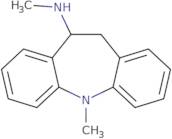Metapramine
CAS: 21730-16-5
Rif. 3D-FM25127
| 5mg | Fuori produzione | ||
| 10mg | Fuori produzione | ||
| 25mg | Fuori produzione | ||
| 50mg | Fuori produzione | ||
| 100mg | Fuori produzione |
Informazioni sul prodotto
- 10,11-Dihydro-N,5-dimethyl-5H-dibenz[b,f]azepin-10-amine5-Methyl-10-methylamino-10,11-dihydrodibenzo[b,f]azepineMetapramine
- 10,11-Dihydro-5-methyl-10-(methylamino)-5H-dibenz[b,f]azepine
- 10,11-Dihydro-N,5-dimethyl-5H-dibenz[b,f]azepin-10-amine
- 21730-16-5
- 5-Methyl-10-methylamino-10,11-dihydrodibenzo[b,f]azepine
- 5H-Dibenz[b,f]azepin-10-amine, 10,11-dihydro-N,5-dimethyl-
- 5H-Dibenz[b,f]azepine, 10,11-dihydro-5-methyl-10-(methylamino)-
- N,5-Dimethyl-10,11-dihydro-5H-dibenzo[b,f]azepin-10-amine
- Rp 19560
- Timaxel
- Vedi altri sinonimi
Metapramine is a drug that belongs to the group of tricyclic antidepressant drugs. It is used in the treatment of chronic oral infections, such as periodontitis and dental caries, as well as infectious diseases. Metapramine has been shown to inhibit the activity of toll-like receptor 2 (TLR2) and TLR4, which are receptors that recognize bacterial and viral components. The pharmacological effects of metapramine are mediated by its ability to bind to adenosine A3 receptors. This binding inhibits the release of proinflammatory cytokines and chemokines from immune cells that have been stimulated by Toll-like receptor ligands. Metapramine is also known for its cardiac effects, including prolongation of QT interval on ECG recordings.





